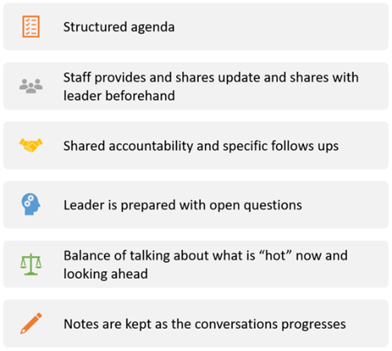As leaders, we are not measured by the hours that we work or our individual achievements, but by the collective contributions of our teams to organizational goals. We need to get everybody to understand their purpose, give their best, and pull in the same direction.
Achieving this collective success is a balancing act. We have to be able to motivate and retain our high-performing team members and also effectively develop those individuals would otherwise find comfort in their zones of familiarity. Everybody needs to feel part of the team.
Having meaningful conversations is critical to achieving this balance. These dialogues provide powerful insights to help coach team members to their highest potential as well as early warning signs to address potential issues.
Busy IT leaders may find making the time for this individual attention onerous. But failing to invest in these one-on-one engagements renders other goal setting and development efforts less effective at best or entirely fruitless at worse. When team members aren’t recognized as individuals, they can feel like replaceable cogs in a big machine. Without these purposeful conversations, the ideal of well-aligned OKRs (Objectives and Key Results) can quickly deteriorate into a bureaucratic checking of boxes — a waste of everyone’s time.
Even more importantly, these conversations are the foundation for identifying obstacles to team performance. It may sound counterintuitive, but understanding and addressing the individual needs of team members is one of the best ways to drive team cohesion.
Anatomy of a Purposeful Dialogue
Fostering a shared understanding of each individual’s contribution to the team's objectives, motivating them to perform at their best, and eliminating obstacles from their path is the foundation on which to build team alignment and achievement. The best way to do this is with regular, purposeful conversations.
These one-on-ones are neither casual chit-chat nor scripted monologues. They are dialogues centered around the team member’s needs, challenges, and aspirations. Importantly, the team member sets the agenda, sharing what's top of mind, what's on the horizon, and any issues or questions. The leader or manager comes prepared to coach, check progress, and address various topics from information sharing to development opportunities.

The leader should be prepared with open-ended questions to keep the dialogue going. They should also take notes during these conversations, which will serve as fuel for subsequent discussions.
Regular and predictable scheduling of these dialogues is essential. Accountability is a two-way street, with leaders not only offering feedback, guidance, and direction, but also addressing individual questions and challenges.
|
Related article: The Untapped Potential of Hidden Knowledge in IT By Christoph Hesterbrink |
The Concept at Work
The best way to understand the power of these conversations is with some real-life examples.
Crystal, an accomplished analyst, consistently met deadlines and was well-liked within her team. However, it was evident during our regular one-one-one meetings that she was growing bored and seeking a change. While she was unsure of how to go about it, we explored potential career goals that aligned with both her desire for a more challenging role and the IT organization’s needs.
These conversations became the catalyst for Crystal’s transition into the role of business relationship manager, bridging the gap between the business and IT. Her work in this new role led to improved alignment between IT and the business, a sharper focus on essential goals, and the elimination of much low-priority work, all the while providing Crystal with a greater challenge and more fulfillment.
Vikram, a development team lead, worked primarily as an individual contributor occasionally handling tasks such as peer reviews and unit test results. He expressed interest in becoming a manager but struggled to articulate how he would meet the additional responsibilities.
For Vikram, these one-on-one conversations became a platform for self-reflection and growth. With greater guidance on preparing for a managerial role, his motivation soared and he and his developers became a rockstar team.
Simple Doesn’t Mean Easy
The idea of structured, goal-centered one-one-on conversations may sound obvious — or even simple. But effective implementation requires significant effort and resolve from leaders. Preparing for, conducting, and maintaining these individual dialogues doesn’t come easy, particularly for those leaders or managers who haven’t pursued this approach before.
Leaders may encounter situations where a team member appears unprepared for the conversation, for example. In such circumstances, I’ve found that taking notes during the meeting on behalf of the team member is valuable. While this might cause a slight sense of embarrassment for the individual involved, it usually serves as a valuable and constructive lesson. (And you’ll both need those notes for your next conversation anyway.) In most cases, such an intervention is necessary only once.
Conducting these conversations — and setting the expectation that the team member is in charge — sends a clear message that leadership is expected at every level within the organization. For individual contributors, these discussions require regular self-reflection regarding their performance and contributions to the organization's objectives that may not otherwise occur. For managers, they underscore the importance of understanding their team members' perspectives and facilitating their success.
The specifics of what these dialogues look like, how frequently they occur, and what happens after them will differ by leader or organization. No matter the tools or techniques employed, these purposeful one-on-one conversations are the cornerstone of effective leadership. They are the key driver of both team accomplishments and individual growth. IT leaders who embrace this approach foster greater alignment, empower individuals to advance their careers, and propel their teams toward success.

Written by Christoph Hesterbrink
Christoph Hesterbrink is a seasoned technology executive with more than 25 years of experience driving innovation and leading IT initiatives for top consulting firms and corporations. Today, Christoph works as an independent advisor and consultant leveraging technology to empower businesses and drive growth with specialties in SAP, Salesforce, ServiceNow, and Rapid Response. Outside of work, he actively engages in non-profit initiatives, seeking to make a positive impact in the community.



